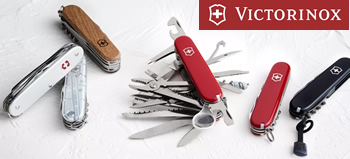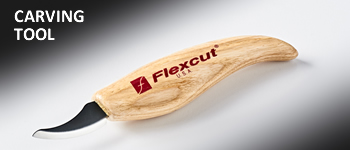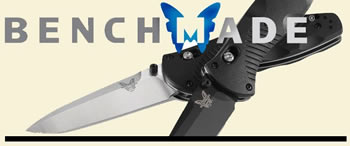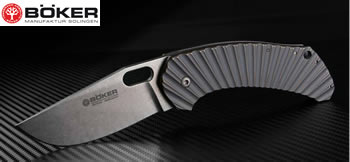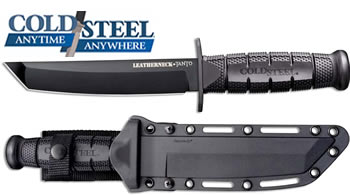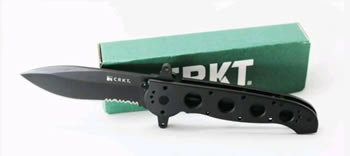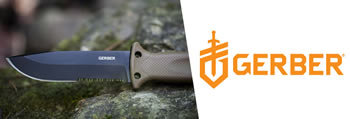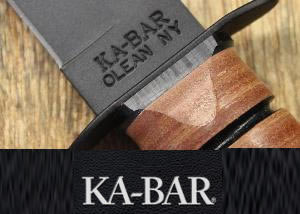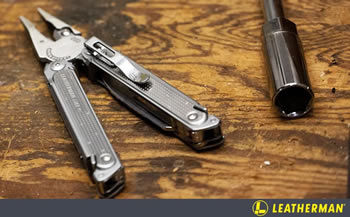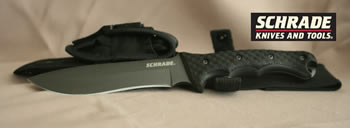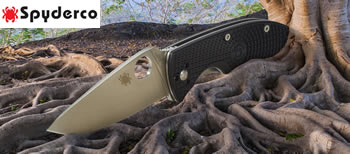see OUR COMPANY / PURCHASE CONDITIONS
SPECIAL DISCOUNTS
December / Diciembre 2025
Ref: (0)
Art: (0)
Amount: (0)
Art: (0)
*** El carrito esta vacio ***
Amount: (0)
Art: (0)
*** El carrito esta vacio ***

Good to do never lacks a prize
Brands
-
 3 Claveles
3 Claveles
- Alveolate Knives
- Axe Kitchen
- Baby Scissors
- Bavaria Knives
- Block Knives
- Boning Knives
- Bread Knives
- Butcher Knives
- Ceramic Knives
- Chef Knives
- Chef Knives
- Cleaver
- Construction
- Construction Tools
- Deba Knives
- Electrician Scissors
- Fisherman Knives
- Folding Knives
- Gardening
- Gardening Tools
- Hairdressing Scissors
- Ham Knives
- Hostelry
- Japanese Knives
- Kitchen
- Kitchen Accessories
- Kitchen Gadgets
- Kitchen Games
- Kitchen Knives
- Kitchen Scissors
- Kitchen Utensils
- Knives
- Knives Briefcases
- Left Handed Knives
- Lefties Scissors
- Magnetic Stands
- Manicure Scissors
- Meat Knives
- Nose Scissors
- Pedicure Pliers
- Peeler Knives
- Personal Items
- Philetaerus Knives
- Professional Knives
- Professional Scissors
- Prune Scissors
- Razor
- Santoku Knives
- Scissors
- Set Knives
- Several Uses Scissors
- Sewing Scissors
- Sharpeners
- Skinner Knives
- Table Knives
- Tailor Scissors
- Uniblock Knives
- Usuba Knives
- Vegetable Knives
- Vintage Scissors
-
 Aitor
Aitor
- Axe
- Bayonet
- Bowie Knives
- Comando Knives
- Crow Knives
- Delfin Knives
- Folding Knives
- Hammerhead Knives
- Hunting Knives
- Jungle King Knives
- Knives
- Military Knives
- Montero Knives
- Mountain Knives
- Multipurpose Pocket Knives
- One Knives
- Oso Knives
- Poseidon Knives
- Saw Knives
- Scuba Diving Knives
- Survival Knives
- Tactical Knives
- Tercio Knives
- Tiburon Knives
- Zero Knives
-
 Albainox
Albainox
- Air Compressed
- Airsoft
- Airsoft Accessories
- Arms
- Cutlasses
- Equipment
- Equipment Airsoft
- Flashlights
- Guns Reply
- Guns Spring
- Ham Support
- Hunting Axe
- Kitchen
- Kitchen Utensils
- Knives
- Machine Guns Reply
- Manicure Scissors
- Military Equipment
- Military Knives
- Prismatics
- Rifles Reply
- Rifles Spring
- Scissors
- Scuba Diving Knives
- Several Uses Scissors
- Sewing Scissors
- Sharpeners
- Survival Knives
- Tactical Knives
- Throwers Knives
- Wine Boots
-
 Amont
Amont
-
 Anza
Anza
-
 Arcos
Arcos
- Alveolate Knives
- Block Knives
- Boning Knives
- Bread Knives
- Butcher Knives
- Chef Knives
- Chef Knives
- Chicken Scissors
- Classical Knives
- Cleaver
- Colour Prof Knives
- Cutlery
- Deba Knives
- Electrician Scissors
- Fisherman Knives
- Flounder Knives
- Folding Knives
- Ham Knives
- Ham Support
- Hostelry
- Japanese Knives
- Kitchen
- Kitchen Accessories
- Kitchen Gadgets
- Kitchen Gloves
- Kitchen Knives
- Kitchen Scissors
- Kitchen Utensils
- Knives
- Knives Bags
- Knives Briefcases
- Knives Set
- Kyoto Knives
- Magnetic Stands
- Manicure Scissors
- Meat Knives
- Pastry Knives
- Peeler Knives
- Philetaerus Knives
- Pots
- Professional Knives
- Professional Scissors
- Riviera Knives
- Saeta Knives
- Santoku Knives
- Saw Knives
- Scissors
- Set Knives
- Several Uses Scissors
- Sewing Scissors
- Sharpeners
- Skillet
- Table Knives
- Tomatoes Knives
- Universal Knives
- Usuba Knives
- Vegetable Knives
-
 Artisancutlery
Artisancutlery
-
 Benchmade
Benchmade
-
 Blackfox
Blackfox
-
 Boker
Boker
- Artisans Folding Knives
- Axe
- Bowie Knives
- Bushcraft Knives
- Chef Knives
- Chef Knives
- Classic Pocket Knives
- Craftsmen Knives
- Cutlasses
- Damascus Folding Knives
- Damascus Knives
- Folding Knives
- Hunting Folding Knives
- Hunting Knives
- Kitchen
- Kitchen Knives
- Knives
- Military Knives
- Military Knives
- Multipurpose Pocket Knives
- Professional Knives
- Santoku Knives
- Table Knives
- Tactical Knives
- Tactics Folding Knives
-
 Bradford
Bradford
-
 Buck
Buck
-
 Bunmei
Bunmei
-
 Byrd
Byrd
-
 Coldsteel
Coldsteel
- Bowie Knives
- Chef Knives
- Chef Knives
- Cutlasses
- Daggers
- Folding Knives
- Functional Swords
- Hunting Axe
- Hunting Knives
- Katanas
- Kitchen
- Kitchen Knives
- Knives
- Medieval Swords
- Military Knives
- Military Knives
- Sabers
- Saw Knives
- Scottish Swords
- Survival Knives
- Swords
- Tactical Knives
- Tactics Folding Knives
- Throwers Knives
- Two Hands Swords
-
 Condor
Condor
-
 Cudeman
Cudeman
- Beret Green Knives
- Bowie Knives
- BS9 Knives
- Bushcraft Knives
- Classic Pocket Knives
- Daggers
- Finished Knives
- Folding Knives
- Hunting Axe
- Hunting Folding Knives
- Hunting Knives
- Jjsk Knives
- Knives
- Leather Pocketknives
- Military Knives
- Mountain Knives
- Mountain Knives
- MT1 Knives
- MT2 Knives
- MT3 Knives
- MT4 Folding Knives
- MT5 Knives
- MT6 Folding Knives
- MT7 Folding Knives
- MT8 Folding Knives
- Saw Knives
- Skinner Knives
- Stylet Pocket Knives
- Stylet Pocket Knives
- Survival Knives
- Tactical Knives
- Tactics Folding Knives
-
 Dawsonknives
Dawsonknives
-
 Denix
Denix
-
 Esee
Esee
-
 Exposito
Exposito
- Capaora Pocket Knives
- Albacete Folding Knives
- Artisans Folding Knives
- Banditen Folding Knives
- Bone Folding Knives
- Buffalo Folding Knives
- Classic Pocket Knives
- Craftsmen Knives
- Cut Point Pocket Knives
- Damascus Folding Knives
- Deer Folding Knives
- Folding Knives
- Folding Knives
- Ivory Folding Knives
- Joyita Folding Knives
- Knives
- Machete Folding Knives
- Maple Folding Knives
- Mediterraneo Knives
- Muflon Folding Knives
- Rattle Folding Knives
- Reproduction Folding Knives
- Sevillana Folding Knives
- Silver Folding Knives
- Stylet Pocket Knives
- Zebu Folding Knives
-
 Extrema Ratio
Extrema Ratio
-
 Fallkniven
Fallkniven
-
 Favour
Favour
-
 Fkmd
Fkmd
-
 Flexcut
Flexcut
-
 Flores Cortes
Flores Cortes
- Barbecues
- Bells
- Boning Knives
- Bread Knives
- Buckets
- Butcher Knives
- Chef Knives
- Chef Knives
- Chicken Scissors
- Chimneys
- Classic Pocket Knives
- Cleaver
- Construction
- Construction Accessories
- Construction Tools
- Cowbells
- Cutlasses
- Cutlery
- Door Accessories
- Farrier Tools
- Folding Knives
- Forget Accessories
- Gardening
- Gardening Accessories
- Gardening Tools
- Hairdressing Scissors
- Ham Knives
- Ham Support
- Horseshoes
- Hostelry
- Hostelry Accessories
- Hunting Axe
- Kitchen
- Kitchen Accessories
- Kitchen Knives
- Kitchen Knives
- Kitchen Scissors
- Kitchen Utensils
- Knives
- Manicure Scissors
- Multipurpose Pocket Knives
- Paelleras
- Pots
- Professional Scissors
- Prune Scissors
- Santoku Knives
- Scales
- Scissors
- Several Uses Scissors
- Sewing Scissors
- Sharpeners
- Signalling
- Skillet
- Skimmer
- Smithy
- Vintage Scissors
-
 Fox
Fox
-
 Gamo
Gamo
-
 Gerber
Gerber
-
 Gladius
Gladius
-
 Global
Global
- Alveolate Knives
- Block Knives
- Boning Knives
- Butcher Knives
- Ceramic Knives
- Chef Knives
- Chef Knives
- Cleaver
- Cutlery
- Deba Knives
- Fisherman Knives
- Ham Knives
- Japanese Knives
- Kitchen
- Kitchen Accessories
- Kitchen Knives
- Kitchen Utensils
- Kitchen Utensils
- Knives
- Knives Briefcases
- Left Handed Knives
- Magnetic Stands
- Meat Knives
- Peeler Knives
- Professional Knives
- Santoku Knives
- Sashimi Knives
- Saw Knives
- Sharpen Stones
- Sharpeners
- Tomatoes Knives
- Vegetable Knives
-
 Golden Eagle
Golden Eagle
-
 Hatsan
Hatsan
-
 Hibbenknives
Hibbenknives
-
 Hogue
Hogue
-
 Jjmartinez
Jjmartinez
-
 Jkr
Jkr
-
 Joker
Joker
- Albacete Folding Knives
- Antilope Knives
- Banditen Folding Knives
- Becasse Pocketknives
- Bowie Knives
- Braco Pocketknives
- BS9 Knives
- Bushcraft Knives
- Classic Pocket Knives
- Craftsmen Knives
- Cutlery
- Facochero Knives
- Field Folding Knives
- Finished Knives
- Folding Knives
- Folding Knives
- Gacela Knives
- Gamo Knives
- Hostelry
- Hunting Axe
- Hunting Folding Knives
- Hunting Knives
- Kitchen
- Knives
- Leather Pocketknives
- Leon Knives
- Military Knives
- Mountain Knives
- Mountain Knives
- Oso Knives
- Pointer Pocketknives
- Rak Knives
- Saw Knives
- Skinner Knives
- Stylet Folding Knives
- Stylet Pocket Knives
- Survival Knives
- Tactical Knives
- Throwers Knives
- Tigre Knives
- Venado Knives
- Vikingo Knives
- Zorro Knives
-
 Jv Cda
Jv Cda
- Axarquia Knives
- Boel Knives
- Bowie Knives
- Bushcraft Knives
- Celtibero Knives
- Chacal Knives
- Classic Pocket Knives
- Comando Knives
- Combat Knives
- Craftsmen Knives
- Cutlasses
- Daggers
- Damascus Folding Knives
- Erroi Knives
- Explorer Knives
- Ezapac Knives
- Falcran Knives
- Fanton Knives
- Finished Knives
- Folding Knives
- Gladius Knives
- Hispanus Knives
- Hobbit Knives
- Hunting Axe
- Hunting Folding Knives
- Hunting Knives
- Knives
- Limited Edition Knives
- Macho Riojano Knives
- Military Knives
- Mountain Knives
- Murcielago Knives
- Outlander Knives
- Scuba Diving Knives
- Sharpeners
- Survival Knives
- Tactical Knives
- Tactics Folding Knives
- Tartesus Knives
-
 K25
K25
-
 Kabar
Kabar
-
 Kai
Kai
- Alveolate Knives
- Block Knives
- Boning Knives
- Chef Knives
- Chef Knives
- Cleaver
- Damascus Knives
- Deba Knives
- Japanese Knives
- Kitchen
- Kitchen Accessories
- Kitchen Gadgets
- Kitchen Knives
- Kitchen Utensils
- Knives
- Knives Briefcases
- Left Handed Knives
- Lefties Scissors
- Manicure Scissors
- Nose Scissors
- Philetaerus Knives
- Santoku Knives
- Scissors
- Set Knives
- Several Uses Scissors
- Sewing Scissors
- Sharpeners
-
 Kanetsune
Kanetsune
-
 Kasumi
Kasumi
-
 Kershaw
Kershaw
-
 Kizer
Kizer
-
 Kizlyar
Kizlyar
-
 Knifemaking
Knifemaking
-
 Leatherman
Leatherman
-
 Mam
Mam
-
 Martinez Gascon
Martinez Gascon
- Alveolate Knives
- Block Knives
- Butcher Knives
- Chef Knives
- Chef Knives
- Chicken Scissors
- Cleaver
- Cutlasses
- Ham Knives
- Hostelry
- Kitchen
- Kitchen Gloves
- Kitchen Knives
- Kitchen Scissors
- Kitchen Utensils
- Knives
- Philetaerus Knives
- Professional Knives
- Professional Scissors
- Santoku Knives
- Scissors
- Set Knives
- Several Uses Scissors
- Sharpeners
-
 Marto
Marto
-
 Miyabi
Miyabi
-
 Morakniv
Morakniv
-
 Muela
Muela
- Artisans Folding Knives
- Bowie Knives
- Braco Knives
- Bushcraft Knives
- Chef Knives
- Classic Pocket Knives
- Cleaver
- Craftsmen Knives
- Criollo Knives
- Curro Folding Knives
- Damascus Folding Knives
- Damascus Knives
- Duque Knives
- Field Folding Knives
- Finished Knives
- Folding Knives
- Folding Knives
- Hunting Axe
- Hunting Folding Knives
- Hunting Knives
- Husky Knives
- Kitchen
- Kitchen Knives
- Knives
- Kodiak Knives
- Leather Pocketknives
- Left Handed Knives
- Limited Edition Knives
- Magnum Knives
- Military Knives
- Military Knives
- Mountain Knives
- Mountain Knives
- Navalia Folding Knives
- Podenqueros Knives
- Rhino Knives
- Santoku Knives
- Scuba Diving Knives
- Set Knives
- Setter Knives
- Sharpeners
- Skinner Knives
- Survival Knives
- Tactical Knives
- Tactics Folding Knives
- Throwers Knives
-
 Muhle
Muhle
-
 Nieto
Nieto
- Artisans Folding Knives
- Bowie Knives
- Bushcraft Knives
- Cetreria Knives
- Chaman Knives
- Cheyenne Knives
- Classic Pocket Knives
- Combat Knives
- Coyote Knives
- Craftsmen Knives
- Damascus Knives
- Field Folding Knives
- Fighter Knives
- Finished Knives
- Folding Knives
- Gaucho Knives
- Hunting Axe
- Hunting Folding Knives
- Hunting Knives
- Kitchen
- Kitchen Knives
- Knives
- Limited Edition Knives
- Military Knives
- Military Knives
- Mountain Knives
- Pegasus Knives
- Safari Knives
- Skinner Knives
- Stylet Folding Knives
- Stylet Pocket Knives
- Survival Knives
- Table Knives
- Tactical Knives
- Tactics Folding Knives
- Throwers Knives
- Toro Knives
- Warfare Knives
-
 Ontario
Ontario
-
 Opinel
Opinel
-
 Pallares
Pallares
-
 Puma
Puma
-
 Rambo
Rambo
-
 Realsteel
Realsteel
-
 Schrade
Schrade
-
 Sog
Sog
-
 Spyderco
Spyderco
-
 Third
Third
-
 Tojiro
Tojiro
-
 Tokisu
Tokisu
-
 Tole10
Tole10
-
 Tops
Tops
-
 Unitedcutlery
Unitedcutlery
-
 Victorinox
Victorinox
- Accessories
- Alveolate Knives
- Block Knives
- Butcher Knives
- Chef Knives
- Chef Knives
- Classic Pocket Knives
- Cleaver
- Electrician Scissors
- Folding Knives
- Ham Knives
- Hunting Axe
- Kitchen
- Kitchen Knives
- Kitchen Utensils
- Knives
- Leather Pocketknives
- Left Handed Knives
- Letter Opener
- Multipurpose
- Multipurpose Pocket Knives
- Philetaerus Knives
- Saw Knives
- Scissors
- Set Knives
- Several Uses Scissors
- Table Knives
- Tools Multipurpose
- Vegetable Knives
-
 Windlass
Windlass
-
 Woll
Woll
-
 Wusthof
Wusthof
- Alveolate Knives
- Block Knives
- Boning Knives
- Bread Knives
- Butcher Knives
- Chef Knives
- Chef Knives
- Hairdressing Scissors
- Ham Knives
- Kitchen
- Kitchen Accessories
- Kitchen Knives
- Kitchen Scissors
- Kitchen Utensils
- Knives
- Knives Briefcases
- Manicure Scissors
- Nose Scissors
- Pastry Knives
- Philetaerus Knives
- Professional Knives
- Santoku Knives
- Saw Knives
- Scissors
- Set Knives
- Several Uses Scissors
- Sharpeners
- Table Knives
-
 Zerotolerance
Zerotolerance
-
 Zwilling
Zwilling
- Block Knives
- Butcher Knives
- Chef Knives
- Chef Knives
- Ham Knives
- Kitchen
- Kitchen Knives
- Kitchen Knives
- Kitchen Utensils
- Lefties Scissors
- Meat Knives
- Pastry Knives
- Philetaerus Knives
- Professional Knives
- Santoku Knives
- Scissors
- Set Knives
- Several Uses Scissors
- Sewing Scissors
- Sharpeners
- Tailor Scissors
- Vegetable Knives
Brands
 3 Claveles
3 Claveles
- Alveolate Knives
- Axe Kitchen
- Baby Scissors
- Bavaria Knives
- Block Knives
- Boning Knives
- Bread Knives
- Butcher Knives
- Ceramic Knives
- Chef Knives
- Chef Knives
- Cleaver
- Construction
- Construction Tools
- Deba Knives
- Electrician Scissors
- Fisherman Knives
- Folding Knives
- Gardening
- Gardening Tools
- Hairdressing Scissors
- Ham Knives
- Hostelry
- Japanese Knives
- Kitchen
- Kitchen Accessories
- Kitchen Gadgets
- Kitchen Games
- Kitchen Knives
- Kitchen Scissors
- Kitchen Utensils
- Knives
- Knives Briefcases
- Left Handed Knives
- Lefties Scissors
- Magnetic Stands
- Manicure Scissors
- Meat Knives
- Nose Scissors
- Pedicure Pliers
- Peeler Knives
- Personal Items
- Philetaerus Knives
- Professional Knives
- Professional Scissors
- Prune Scissors
- Razor
- Santoku Knives
- Scissors
- Set Knives
- Several Uses Scissors
- Sewing Scissors
- Sharpeners
- Skinner Knives
- Table Knives
- Tailor Scissors
- Uniblock Knives
- Usuba Knives
- Vegetable Knives
- Vintage Scissors
 Aitor
Aitor
- Axe
- Bayonet
- Bowie Knives
- Comando Knives
- Crow Knives
- Delfin Knives
- Folding Knives
- Hammerhead Knives
- Hunting Knives
- Jungle King Knives
- Knives
- Military Knives
- Montero Knives
- Mountain Knives
- Multipurpose Pocket Knives
- One Knives
- Oso Knives
- Poseidon Knives
- Saw Knives
- Scuba Diving Knives
- Survival Knives
- Tactical Knives
- Tercio Knives
- Tiburon Knives
- Zero Knives
 Albainox
Albainox
- Air Compressed
- Airsoft
- Airsoft Accessories
- Arms
- Cutlasses
- Equipment
- Equipment Airsoft
- Flashlights
- Guns Reply
- Guns Spring
- Ham Support
- Hunting Axe
- Kitchen
- Kitchen Utensils
- Knives
- Machine Guns Reply
- Manicure Scissors
- Military Equipment
- Military Knives
- Prismatics
- Rifles Reply
- Rifles Spring
- Scissors
- Scuba Diving Knives
- Several Uses Scissors
- Sewing Scissors
- Sharpeners
- Survival Knives
- Tactical Knives
- Throwers Knives
- Wine Boots
 Amont
Amont
 Anza
Anza
 Arcos
Arcos
- Alveolate Knives
- Block Knives
- Boning Knives
- Bread Knives
- Butcher Knives
- Chef Knives
- Chef Knives
- Chicken Scissors
- Classical Knives
- Cleaver
- Colour Prof Knives
- Cutlery
- Deba Knives
- Electrician Scissors
- Fisherman Knives
- Flounder Knives
- Folding Knives
- Ham Knives
- Ham Support
- Hostelry
- Japanese Knives
- Kitchen
- Kitchen Accessories
- Kitchen Gadgets
- Kitchen Gloves
- Kitchen Knives
- Kitchen Scissors
- Kitchen Utensils
- Knives
- Knives Bags
- Knives Briefcases
- Knives Set
- Kyoto Knives
- Magnetic Stands
- Manicure Scissors
- Meat Knives
- Pastry Knives
- Peeler Knives
- Philetaerus Knives
- Pots
- Professional Knives
- Professional Scissors
- Riviera Knives
- Saeta Knives
- Santoku Knives
- Saw Knives
- Scissors
- Set Knives
- Several Uses Scissors
- Sewing Scissors
- Sharpeners
- Skillet
- Table Knives
- Tomatoes Knives
- Universal Knives
- Usuba Knives
- Vegetable Knives
 Artisancutlery
Artisancutlery
 Benchmade
Benchmade
 Blackfox
Blackfox
 Boker
Boker
- Artisans Folding Knives
- Axe
- Bowie Knives
- Bushcraft Knives
- Chef Knives
- Chef Knives
- Classic Pocket Knives
- Craftsmen Knives
- Cutlasses
- Damascus Folding Knives
- Damascus Knives
- Folding Knives
- Hunting Folding Knives
- Hunting Knives
- Kitchen
- Kitchen Knives
- Knives
- Military Knives
- Military Knives
- Multipurpose Pocket Knives
- Professional Knives
- Santoku Knives
- Table Knives
- Tactical Knives
- Tactics Folding Knives
 Bradford
Bradford
 Buck
Buck
 Bunmei
Bunmei
 Byrd
Byrd
 Coldsteel
Coldsteel
- Bowie Knives
- Chef Knives
- Chef Knives
- Cutlasses
- Daggers
- Folding Knives
- Functional Swords
- Hunting Axe
- Hunting Knives
- Katanas
- Kitchen
- Kitchen Knives
- Knives
- Medieval Swords
- Military Knives
- Military Knives
- Sabers
- Saw Knives
- Scottish Swords
- Survival Knives
- Swords
- Tactical Knives
- Tactics Folding Knives
- Throwers Knives
- Two Hands Swords
 Condor
Condor
 Cudeman
Cudeman
- Beret Green Knives
- Bowie Knives
- BS9 Knives
- Bushcraft Knives
- Classic Pocket Knives
- Daggers
- Finished Knives
- Folding Knives
- Hunting Axe
- Hunting Folding Knives
- Hunting Knives
- Jjsk Knives
- Knives
- Leather Pocketknives
- Military Knives
- Mountain Knives
- Mountain Knives
- MT1 Knives
- MT2 Knives
- MT3 Knives
- MT4 Folding Knives
- MT5 Knives
- MT6 Folding Knives
- MT7 Folding Knives
- MT8 Folding Knives
- Saw Knives
- Skinner Knives
- Stylet Pocket Knives
- Stylet Pocket Knives
- Survival Knives
- Tactical Knives
- Tactics Folding Knives
 Dawsonknives
Dawsonknives
 Denix
Denix
 Esee
Esee
 Exposito
Exposito
- Capaora Pocket Knives
- Albacete Folding Knives
- Artisans Folding Knives
- Banditen Folding Knives
- Bone Folding Knives
- Buffalo Folding Knives
- Classic Pocket Knives
- Craftsmen Knives
- Cut Point Pocket Knives
- Damascus Folding Knives
- Deer Folding Knives
- Folding Knives
- Folding Knives
- Ivory Folding Knives
- Joyita Folding Knives
- Knives
- Machete Folding Knives
- Maple Folding Knives
- Mediterraneo Knives
- Muflon Folding Knives
- Rattle Folding Knives
- Reproduction Folding Knives
- Sevillana Folding Knives
- Silver Folding Knives
- Stylet Pocket Knives
- Zebu Folding Knives
 Extrema Ratio
Extrema Ratio
 Fallkniven
Fallkniven
 Favour
Favour
 Fkmd
Fkmd
 Flexcut
Flexcut
 Flores Cortes
Flores Cortes
- Barbecues
- Bells
- Boning Knives
- Bread Knives
- Buckets
- Butcher Knives
- Chef Knives
- Chef Knives
- Chicken Scissors
- Chimneys
- Classic Pocket Knives
- Cleaver
- Construction
- Construction Accessories
- Construction Tools
- Cowbells
- Cutlasses
- Cutlery
- Door Accessories
- Farrier Tools
- Folding Knives
- Forget Accessories
- Gardening
- Gardening Accessories
- Gardening Tools
- Hairdressing Scissors
- Ham Knives
- Ham Support
- Horseshoes
- Hostelry
- Hostelry Accessories
- Hunting Axe
- Kitchen
- Kitchen Accessories
- Kitchen Knives
- Kitchen Knives
- Kitchen Scissors
- Kitchen Utensils
- Knives
- Manicure Scissors
- Multipurpose Pocket Knives
- Paelleras
- Pots
- Professional Scissors
- Prune Scissors
- Santoku Knives
- Scales
- Scissors
- Several Uses Scissors
- Sewing Scissors
- Sharpeners
- Signalling
- Skillet
- Skimmer
- Smithy
- Vintage Scissors
 Fox
Fox
 Gamo
Gamo
 Gerber
Gerber
 Gladius
Gladius
 Global
Global
- Alveolate Knives
- Block Knives
- Boning Knives
- Butcher Knives
- Ceramic Knives
- Chef Knives
- Chef Knives
- Cleaver
- Cutlery
- Deba Knives
- Fisherman Knives
- Ham Knives
- Japanese Knives
- Kitchen
- Kitchen Accessories
- Kitchen Knives
- Kitchen Utensils
- Kitchen Utensils
- Knives
- Knives Briefcases
- Left Handed Knives
- Magnetic Stands
- Meat Knives
- Peeler Knives
- Professional Knives
- Santoku Knives
- Sashimi Knives
- Saw Knives
- Sharpen Stones
- Sharpeners
- Tomatoes Knives
- Vegetable Knives
 Golden Eagle
Golden Eagle
 Hatsan
Hatsan
 Hibbenknives
Hibbenknives
 Hogue
Hogue
 Jjmartinez
Jjmartinez
 Jkr
Jkr
 Joker
Joker
- Albacete Folding Knives
- Antilope Knives
- Banditen Folding Knives
- Becasse Pocketknives
- Bowie Knives
- Braco Pocketknives
- BS9 Knives
- Bushcraft Knives
- Classic Pocket Knives
- Craftsmen Knives
- Cutlery
- Facochero Knives
- Field Folding Knives
- Finished Knives
- Folding Knives
- Folding Knives
- Gacela Knives
- Gamo Knives
- Hostelry
- Hunting Axe
- Hunting Folding Knives
- Hunting Knives
- Kitchen
- Knives
- Leather Pocketknives
- Leon Knives
- Military Knives
- Mountain Knives
- Mountain Knives
- Oso Knives
- Pointer Pocketknives
- Rak Knives
- Saw Knives
- Skinner Knives
- Stylet Folding Knives
- Stylet Pocket Knives
- Survival Knives
- Tactical Knives
- Throwers Knives
- Tigre Knives
- Venado Knives
- Vikingo Knives
- Zorro Knives
 Jv Cda
Jv Cda
- Axarquia Knives
- Boel Knives
- Bowie Knives
- Bushcraft Knives
- Celtibero Knives
- Chacal Knives
- Classic Pocket Knives
- Comando Knives
- Combat Knives
- Craftsmen Knives
- Cutlasses
- Daggers
- Damascus Folding Knives
- Erroi Knives
- Explorer Knives
- Ezapac Knives
- Falcran Knives
- Fanton Knives
- Finished Knives
- Folding Knives
- Gladius Knives
- Hispanus Knives
- Hobbit Knives
- Hunting Axe
- Hunting Folding Knives
- Hunting Knives
- Knives
- Limited Edition Knives
- Macho Riojano Knives
- Military Knives
- Mountain Knives
- Murcielago Knives
- Outlander Knives
- Scuba Diving Knives
- Sharpeners
- Survival Knives
- Tactical Knives
- Tactics Folding Knives
- Tartesus Knives
 K25
K25
 Kabar
Kabar
 Kai
Kai
- Alveolate Knives
- Block Knives
- Boning Knives
- Chef Knives
- Chef Knives
- Cleaver
- Damascus Knives
- Deba Knives
- Japanese Knives
- Kitchen
- Kitchen Accessories
- Kitchen Gadgets
- Kitchen Knives
- Kitchen Utensils
- Knives
- Knives Briefcases
- Left Handed Knives
- Lefties Scissors
- Manicure Scissors
- Nose Scissors
- Philetaerus Knives
- Santoku Knives
- Scissors
- Set Knives
- Several Uses Scissors
- Sewing Scissors
- Sharpeners
 Kanetsune
Kanetsune
 Kasumi
Kasumi
 Kershaw
Kershaw
 Kizer
Kizer
 Kizlyar
Kizlyar
 Knifemaking
Knifemaking
 Leatherman
Leatherman
 Mam
Mam
 Martinez Gascon
Martinez Gascon
- Alveolate Knives
- Block Knives
- Butcher Knives
- Chef Knives
- Chef Knives
- Chicken Scissors
- Cleaver
- Cutlasses
- Ham Knives
- Hostelry
- Kitchen
- Kitchen Gloves
- Kitchen Knives
- Kitchen Scissors
- Kitchen Utensils
- Knives
- Philetaerus Knives
- Professional Knives
- Professional Scissors
- Santoku Knives
- Scissors
- Set Knives
- Several Uses Scissors
- Sharpeners
 Marto
Marto
 Miyabi
Miyabi
 Morakniv
Morakniv
 Muela
Muela
- Artisans Folding Knives
- Bowie Knives
- Braco Knives
- Bushcraft Knives
- Chef Knives
- Classic Pocket Knives
- Cleaver
- Craftsmen Knives
- Criollo Knives
- Curro Folding Knives
- Damascus Folding Knives
- Damascus Knives
- Duque Knives
- Field Folding Knives
- Finished Knives
- Folding Knives
- Folding Knives
- Hunting Axe
- Hunting Folding Knives
- Hunting Knives
- Husky Knives
- Kitchen
- Kitchen Knives
- Knives
- Kodiak Knives
- Leather Pocketknives
- Left Handed Knives
- Limited Edition Knives
- Magnum Knives
- Military Knives
- Military Knives
- Mountain Knives
- Mountain Knives
- Navalia Folding Knives
- Podenqueros Knives
- Rhino Knives
- Santoku Knives
- Scuba Diving Knives
- Set Knives
- Setter Knives
- Sharpeners
- Skinner Knives
- Survival Knives
- Tactical Knives
- Tactics Folding Knives
- Throwers Knives
 Muhle
Muhle
 Nieto
Nieto
- Artisans Folding Knives
- Bowie Knives
- Bushcraft Knives
- Cetreria Knives
- Chaman Knives
- Cheyenne Knives
- Classic Pocket Knives
- Combat Knives
- Coyote Knives
- Craftsmen Knives
- Damascus Knives
- Field Folding Knives
- Fighter Knives
- Finished Knives
- Folding Knives
- Gaucho Knives
- Hunting Axe
- Hunting Folding Knives
- Hunting Knives
- Kitchen
- Kitchen Knives
- Knives
- Limited Edition Knives
- Military Knives
- Military Knives
- Mountain Knives
- Pegasus Knives
- Safari Knives
- Skinner Knives
- Stylet Folding Knives
- Stylet Pocket Knives
- Survival Knives
- Table Knives
- Tactical Knives
- Tactics Folding Knives
- Throwers Knives
- Toro Knives
- Warfare Knives
 Ontario
Ontario
 Opinel
Opinel
 Pallares
Pallares
 Puma
Puma
 Rambo
Rambo
 Realsteel
Realsteel
 Schrade
Schrade
 Sog
Sog
 Spyderco
Spyderco
 Third
Third
 Tojiro
Tojiro
 Tokisu
Tokisu
 Tole10
Tole10
 Tops
Tops
 Unitedcutlery
Unitedcutlery
 Victorinox
Victorinox
- Accessories
- Alveolate Knives
- Block Knives
- Butcher Knives
- Chef Knives
- Chef Knives
- Classic Pocket Knives
- Cleaver
- Electrician Scissors
- Folding Knives
- Ham Knives
- Hunting Axe
- Kitchen
- Kitchen Knives
- Kitchen Utensils
- Knives
- Leather Pocketknives
- Left Handed Knives
- Letter Opener
- Multipurpose
- Multipurpose Pocket Knives
- Philetaerus Knives
- Saw Knives
- Scissors
- Set Knives
- Several Uses Scissors
- Table Knives
- Tools Multipurpose
- Vegetable Knives
 Windlass
Windlass
 Woll
Woll
 Wusthof
Wusthof
- Alveolate Knives
- Block Knives
- Boning Knives
- Bread Knives
- Butcher Knives
- Chef Knives
- Chef Knives
- Hairdressing Scissors
- Ham Knives
- Kitchen
- Kitchen Accessories
- Kitchen Knives
- Kitchen Scissors
- Kitchen Utensils
- Knives
- Knives Briefcases
- Manicure Scissors
- Nose Scissors
- Pastry Knives
- Philetaerus Knives
- Professional Knives
- Santoku Knives
- Saw Knives
- Scissors
- Set Knives
- Several Uses Scissors
- Sharpeners
- Table Knives
 Zerotolerance
Zerotolerance
 Zwilling
Zwilling
- Block Knives
- Butcher Knives
- Chef Knives
- Chef Knives
- Ham Knives
- Kitchen
- Kitchen Knives
- Kitchen Knives
- Kitchen Utensils
- Lefties Scissors
- Meat Knives
- Pastry Knives
- Philetaerus Knives
- Professional Knives
- Santoku Knives
- Scissors
- Set Knives
- Several Uses Scissors
- Sewing Scissors
- Sharpeners
- Tailor Scissors
- Vegetable Knives
Categories
- Airsoft
- Arms
- Construction
- Equipment
- Gardening
- Hostelry
- Hunting Knives
- Kitchen
- Kitchen Knives
-
Pocket Knives
- Albacete Pocket Knives
- Artisans Pocket Knives
- Bandit Pocket Knives
- Capaora Pocket Knives
- Classic Pocket Knives
- Cut Point Pocket Knive
- Damascus Pocket Knives
- Hunting Pocket Knives
- Ivory Pocket Knives
- Leather Pocketknives
- Military Pocket Knives
- Multipurpose Pocket Knives
- Rattle Pocket Knives
- Razors Knives
- Reproduction Pocket Knives
- Sevillana Pocket Knives
- Silver Pocket Knives
- Stylet Pocket Knives
- Tactics Pocket Knives
- Professional Knives
- Scissors
- Smithy
- Swords
- Tactical Knives
Categories
- Airsoft
- Arms
- Construction
- Equipment
- Gardening
- Hostelry
- Hunting Knives
- Kitchen
- Kitchen Knives
-
Pocket Knives
- Albacete Pocket Knives
- Artisans Pocket Knives
- Bandit Pocket Knives
- Capaora Pocket Knives
- Classic Pocket Knives
- Cut Point Pocket Knive
- Damascus Pocket Knives
- Hunting Pocket Knives
- Ivory Pocket Knives
- Leather Pocketknives
- Military Pocket Knives
- Multipurpose Pocket Knives
- Rattle Pocket Knives
- Razors Knives
- Reproduction Pocket Knives
- Sevillana Pocket Knives
- Silver Pocket Knives
- Stylet Pocket Knives
- Tactics Pocket Knives
- Professional Knives
- Scissors
- Smithy
- Swords
- Tactical Knives
Medieval and legendary swords of history
Evolution and relevant data about medieval swords
The medieval swords around the years have been evolving their design, shape and size to ensure more effectiveness to the one that carries it against its enemy and at the same time have a greater degree of protection.
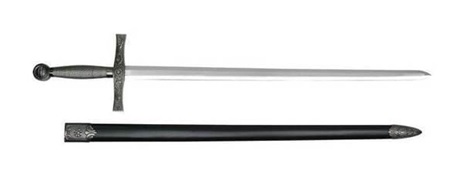
Humans from the Bronze Age made weapons with cutting edges, the sword was made after the dagger. But it was years later that the sword began to be used for combats.
The medieval sword is considered to be a white weapon, it is simply based on being a straight blade with a double edge. It has a handle and can present many variations in its length, grip, weight and more.
In history, the first swords began to appear in the IV millennium BC and these were made of bronze, iron and finally steel.
In the middle ages and specifically with the Crusades, the sword was standardized as a cutting sword with a hilt that was cruciform.
In the fourteenth century many innovations were made especially in the handles. Swords were made a few longer to grab it with both hands. The leaf also was made longer.
The medieval swords have undoubtedly become popular. Swords have been present in many important events for many, many decades.
Medieval Swords and other legendary swords of history
Next you will see the most iconic medieval swords and those of course, have been at the most iconic moments in history.
Sword of the Barbarians and Nordics: This sword terrorized the rivals. It had a huge size compared to the others. Just a warrior with the same characteristics than the weapon could handle its weight, width and length. It was ideal for a single hit and it had to be accurate. The sword was a sign of respect and authority.
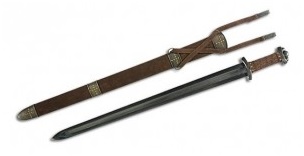
Charlemagne's sword:Charles was emperor of Western Europe and his sword was very modern for the time. It had a very perfect and stylized design. Charles came to conquer territories such as France, Italy and Germany with his sword.
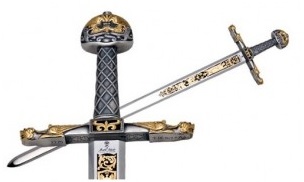
Scimitar sword: Original sword from the Middle East. This sword abounded in its production in the Arab invasion. Toledo was once the most important center of creation for this sword. It has a single edge and its grip protects the hands very well. The sword is curved to make easier to perform an attack riding a horse, then the sword will cut but the blade does not stay there and follow its trajectory.

William Wallace sword:He was a Scottish warrior who supported his country in the wars of Scottish independence.
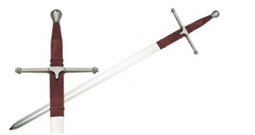
Claymore Sword:Weapon that belonged to James I (1394-1437) King of Scotland (also known as The Lion of Scotland for his firm hand in governing and for being really brave on the battlefield). He was crowned King in 1424 in Scone. Among his feats or most notable acts include reducing the powers of the feudal nobles, crush the Alban House or introduce a system of weights and measures in Scotland. His life ended up being killed by Sir Robert Graham.
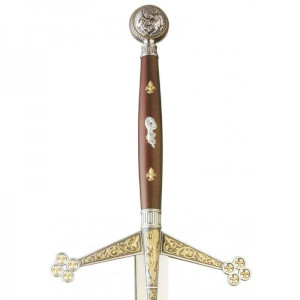
Mandoble sword of the Catholic Kings: Spectacular and mythical Spanish sword with which the Catholic Monarchs (Fernando and Isabel) named Christopher Columbus as a gentleman when he returned from his first trip to the Americas. This sword was used in the important public or religious acts of his mandate, for example the Conquest of the Nasrid Kingdom of Granada.
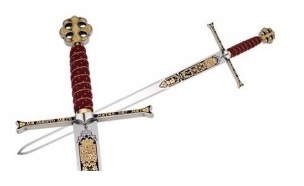
Sword of Christopher Columbus (1436-1506): Sword of the navigator Christopher Columbus who after several attempts was finally supported by the Catholic Monarchs of Spain to undertake the exploration of the Indies in the western seas. Columbus arrived to america on October 12 of 1492 for the first time.

Other legendary swords worthy to mention may be:
Sword of Alexander the Great: Alexander III was from Macedonia and was the king from 336 BC until the day of his death. Many years have passed and he is still considered an important military leader. He was the one who conquered the Aquemenida empire and the Persian Empire. His sword is unique, a lethal weapon with a very elegant grip.
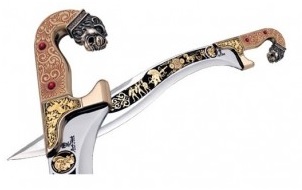
Iberian Falcata:This was the sword of the first people who lived in the Iberian peninsula. The Iberians used this sword to fight on their battles. Its blade design is very different and no other sword like this has been ever seen. It was designed to cut horizontally.

Roman sword:This Roman weapon was a perfect sword for combats man to man. Its handle is excellent because it adapts perfectly to the human hand. The sword is short, pointed and wide. It caused great damage to the opponents.
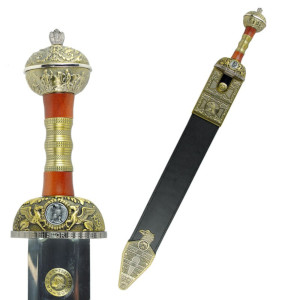
Parts and composition of the swords
The medieval sword but also the rest of swords in general have a blade, handle and scabbard.
The scabbard is what covers the blade and where it is stored when the sword is not in use. There are three types of attacks that can be done with the blade: cut, puncture and tear. The blade can have a single edge or double edge. It could also have a false edge near its tip. The longer side or the edge of the sword is the one that is going to be used to make punches.

The false edge or its shorter side, is the one used to counter attack. The blade could also have notches which helps the blade to be lighter and allow it to be stronger and much stiffer.
Although the hilt might seem not too important is usually one of the most important parts of the sword. It is the part that allows to handle the sword. The swords of the Post Viking era had only one cross guard.
The knob helps to improve the balance and can be used as an instrument to attack short range. The spike is simply an extension of the blade arrangement which passes through the handle.
Every sword must have its sheath and this is the cover for the weapon to rest. In all the years, these covers have been made of many materials, such as leather, metals, bronze and steel.
In the part that the sheath has an opening is where the sword is kept and this is called throat. In this there is a ring or a hook that simply makes the sword enter more easily, be safer and avoid damage to the one who carries the sword.
Free Shipping. (Purchases > 90)Germany, Austria, Belgium, France, Holland, Italy, Luxembourg
Return 30 days
Delivery 2 to 7 days Satisfaction guaranteed
Secure shopping Guaranteed


 Sign in
Sign in +34 931736312
+34 931736312  +34 658373701
+34 658373701
